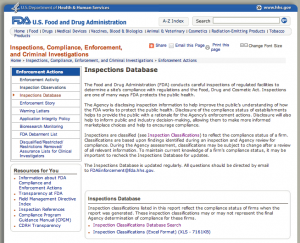 The FDA has recently made public and easily accessible several databases disclosing the results of FDA inspections for companies with compliance issues related to the Food, Drug and Cosmetic Act and results of criminal investigations and debarment actions along with an easy to use warning letter, untitled letter and cyber letter resource. Although such information has always been available from FDA, it could only be obtained by a written request under the Freedom of Information Act (FOIA). However, using the FOIA route involved up to a two year wait to get a response that often was of limited value because the inspection data FDA sent was for an “NAI” (no action indicated) or “VAI” (voluntary action indicated) classified inspection. FOIA requestors are usually looking for regulatory dirt in the form of an “OAI” (official action indicated) inspection result or criminal investigation.
The FDA has recently made public and easily accessible several databases disclosing the results of FDA inspections for companies with compliance issues related to the Food, Drug and Cosmetic Act and results of criminal investigations and debarment actions along with an easy to use warning letter, untitled letter and cyber letter resource. Although such information has always been available from FDA, it could only be obtained by a written request under the Freedom of Information Act (FOIA). However, using the FOIA route involved up to a two year wait to get a response that often was of limited value because the inspection data FDA sent was for an “NAI” (no action indicated) or “VAI” (voluntary action indicated) classified inspection. FOIA requestors are usually looking for regulatory dirt in the form of an “OAI” (official action indicated) inspection result or criminal investigation.
FDA is airing its dirty laundry, granting easy access to inquiring minds by identifying publically which FDA regulated companies have had problems.
Regarding their decision to make the database available the FDA states;
The Agency is disclosing inspection information to help improve the public’s understanding of how the FDA works to protect the public health. Disclosure of the compliance status of establishments helps to provide the public with a rationale for the Agency’s enforcement actions. Disclosure will also help to inform public and industry decision-making, allowing them to make more informed marketplace choices and help to encourage compliance.
But this transparency has a political feeling to it. The committee in Congress responsible for setting FDA’s budget just took a butcher knife to FDA’s resources and FDA is now laying the groundwork for the argument that cutting FDA’s money will result in less successful enforcement actions like those that are now so easily accessible for viewing. Although it sounds like a good argument, the fact is FDA takes so few enforcement actions against the vast regulated industry the reduction in enforcement will hardly be noticeable. Moreover, if FDA were to turn its resources (limited as they are) toward higher risk companies as directed by the same Congress last year, fewer enforcement actions against worse bad guys would be a better outcome.
More than ever it is critical that companies fearing an FDA inspection or investigation or warning letter do all they can to be prepared and compliant. One way is to hire former FDA inspectors, such as those available through FDAImports, to ensure facilities, supply chains, labeling and packaging materials, and current Good Manufacturing Practices controls are in place and adequate. Pre-FDA audits are the most common way for a company to ensure FDA compliance. Direct experience with the FDA-inspection model is a key to success.
A former-FDA “observer” presence during an FDA inspection will assist in converting an inspection from an “OAI” to a “VAI” classification. The former inspector can quickly identify areas of concern likely to be included on an FDA Form 483 as enforcement concerns. Responding rapidly during an inspection by correcting problems can change a bad inspection outcome into a tolerable one. This can be the difference between an “OAI” and a “VAI” classification by FDA.
Finally, FDA’s databases include inspection and investigation results of foreign manufacturers of foods, dietary supplements, cosmetics, drugs and medical devices. Foreign companies listed as “OAI” should expect to find themselves on an FDA Import Alert. Companies listed as “VAI” might also experience this outcome. Their responses to FDA will be critical to avoiding an FDA automatic detention at the border when their products are exported to the USA.
– Benjamin L. England, Founder

